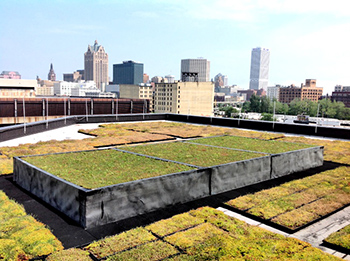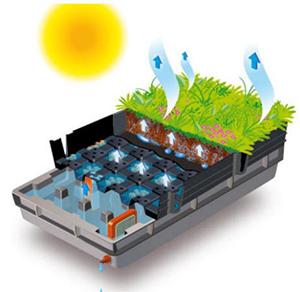Milwaukee Groups Testing Green Roof System
 MILWAUKEE — Vegetal i.D., a Milwaukee company that specializes in green roofing systems, is working with Wisconsin groups to pilot a project that will test innovations in green infrastructure and storm water management.
MILWAUKEE — Vegetal i.D., a Milwaukee company that specializes in green roofing systems, is working with Wisconsin groups to pilot a project that will test innovations in green infrastructure and storm water management.
Based in France, Vegetal’s marketing and R&D location is collaborating with the Milwaukee Metropolitan Sewerage District (MMSD), Fund for Lake Michigan, The Water Council, UW-Milwaukee and UW-Whitewater to monitor the performance of a product called Stock & Flow, which has been installed on the roof of MMSD’s headquarters. The rooftop system combines blue- and green-roof technologies and aims to manage rainfall while reducing water pollution.
Traditional green roofs capture and store water with vegetation and a planting medium such as soil. The green roof that has been on MMSD’s headquarters building for 10 years can hold up to 1,500 gallons of water. According to MMS, blue roofs are able to store several inches of rain on a roof by enlisting low-cost inlet restrictors on roof drains to prevent water from getting into the drain until it reaches a level higher than the inlet restrictor.
With the combination of these two styles, a traditional green-roof planter box sits on top of a tray that holds water like a blue roof. The green-roof tray then captures rainfall, storing storm water, while allowing excess water to fill the blue-roof-style boxes below. The blue-roof boxes can be equipped to empty right before another storm or hold the water so plants in the green-roof boxes above have access to moisture during dry periods.
Vegetal says the new technology is needed because as urban municipalities expand, they create impermeable surfaces that disrupt the natural water cycle. These surfaces create an artificially high rate of water runoff, which becomes increasingly difficult for the wastewater utility to manage and can result in sewage overflows that pollute the local watershed. Because expanding the capacity of a traditional wastewater utility system can be expensive, city engineers have turned to decentralized management systems such as green roofs to deal with wastewater at the source.
“A green roof is like a sponge, and it absorbs a lot of water, but when it’s fully saturated it doesn’t have much effect,” said Gaëlle Bergès, product and development manager of Vegetal i.D, in a release.
 The pilot project will test two versions of the Stock & Flow system. The first uses a flow regulator to create a slow and constant release of water from the roof. During heavy rain, water is retained and then slowly released to the storm sewer system.
The pilot project will test two versions of the Stock & Flow system. The first uses a flow regulator to create a slow and constant release of water from the roof. During heavy rain, water is retained and then slowly released to the storm sewer system.
The second version uses a cloud system that is able to predict rain events. This enables the system to autonomously manage the water that is retained. Water is detained and held during rain events in order to maximize irrigation and retention. When a rain event is predicted, the cloud system purges Stock & Flow before the rain event in order to enable it to capture and detain all rain from the next event and offset peak rain runoff flows.
Vegetal is hoping the cloud-control system picks up steam throughout other municipalities.
“The cloud control runs autonomously using weather data to make its predictions, but it will be equipped with its own online dashboard for monitoring and control,” said Brennon Garthwait, storm water management specialist at Vegetal i.D, in a statement. “This would enable building owners to monitor the health of their system, and allow storm water officials to monitor the systems as a group simultaneously and purge the reservoirs as necessary.”
MMSD has been spearheading a green infrastructure movement for more than 10 years. The goal, known as Fresh Coast 740, is to capture 740 million gallons of water every time it rains. To achieve this goal, the program invests in high-impact green infrastructure such as rainwater harvesting, porous pavement, and bio-swales and by obtaining key pieces of land to remediate into greenways and wetlands that manage great amounts of storm water naturally and increases resistance to flooding.
